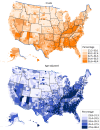Prevalence and Geographic Patterns of Self-Reported Short Sleep Duration Among US Adults, 2020
- PMID: 37384831
- PMCID: PMC10317035
- DOI: 10.5888/pcd20.220400
Prevalence and Geographic Patterns of Self-Reported Short Sleep Duration Among US Adults, 2020
Abstract
We estimated the prevalence of short sleep duration (<7 hours per day) among US adults aged 18 years or older by using 2020 Behavioral Risk Factor Surveillance System data. Nationally, 33.2% of adults reported short sleep duration. We identified disparities across sociodemographic characteristics, including age, sex, race and ethnicity, marital status, education, income, and urbanicity. Counties with the highest model-based estimates of short sleep duration clustered in the Southeast and along the Appalachian Mountains. These findings identified subgroups and geographic areas in which tailored strategies for promotion of optimal sleep duration (≥7 hours per night) are most needed.
Figures

References
-
- Office of Disease Prevention and Health Promotion. Sleep. Healthy People 2030. Accessed October 25, 2022. https://health.gov/healthypeople/objectives-and-data/browse-objectives/s...
-
- Klein RJ, Schoenborn CA. Age adjustment using the 2000 projected U.S. population. Healthy People Stat Notes 2001;(20):1–10. - PubMed
-
- Centers for Disease Control and Prevention. 2020. BRFSS survey data and documentation. Accessed October 25, 2022. https://www.cdc.gov/brfss/annual_data/annual_2020.html
MeSH terms
LinkOut - more resources
Full Text Sources

